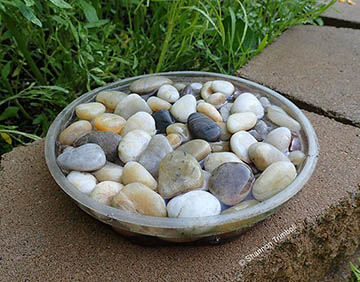Many pollinators will get much of the water they need from the nectar they drink. However, sometimes they need access to additional water sources. Honey bees, especially, need access to lots of water during the summer because they use water to cool their hive. Providing bees and other pollinators with access to water is easy – think of it as making a birdbath for the bees.

The first step is to find some kind of shallow dish or pan that will hold water. A pie pan or old cookie sheet will work fine. The trays that flower pots sit in also work great. If the sides are deep enough, you can decorate the outside, but that’s just for you. The bees won’t care whether it looks pretty. Fill the container with marbles, corks, rocks, slats of wood, etc. Basically, anything that will give the bees and other pollinators a place to land.
Carefully fill the container with water. The water should just poke up through the cracks between the marbles, rocks, corks, etc. Bees, and most pollinators in general, can’t swim and will drown if they fall into the water and can’t crawl back onto something. You want the bees or other pollinators to be able to drink without getting their feet wet because that reduces the chances of them drowning.
Empty and refill the water in the container often enough to keep mosquitos from developing in it. However, unlike with a hummingbird feeder, you don’t have to worry if the water in your bee waterer gets a little scuzzy. Honey bees and some other pollinators actually prefer what we would consider “dirty water.” It is generally believed that they are after the minerals and such that the scuzz / dirt adds to the water. Don’t let it get too gross, but odds are it will probably get “too dirty” for you before it gets “too dirty” for the bees.
That’s all there is to making and maintaining a bee waterer. It can be as fancy or as plain as you want it to be. Place it in a sunny spot where the pollinators are likely to find it, then sit back and enjoy watching bees and other pollinators. Have fun.

This article was part of Shannon’s original Kentucky Pollinators and Backyard Wildlife blog which evolved into the blog for Backyard Ecology.

Backyard Ecology: Exploring Nature in Your Backyard
Nature isn’t just “out there.” It’s all around us, including right outside our doors. Hi, my name is Shannon Trimboli, and I am the host of Backyard Ecology. I live in southcentral Kentucky and am a wildlife biologist, educator, author, beekeeper, and owner of a nursery specializing in plants for pollinators and wildlife conservation. I invite you to join me as we ignite our curiosity and natural wonder, explore our yards and communities, and improve our local pollinator and wildlife habitat. Learn more or subscribe to my email list at www.backyardecology.net.

Leave a Reply